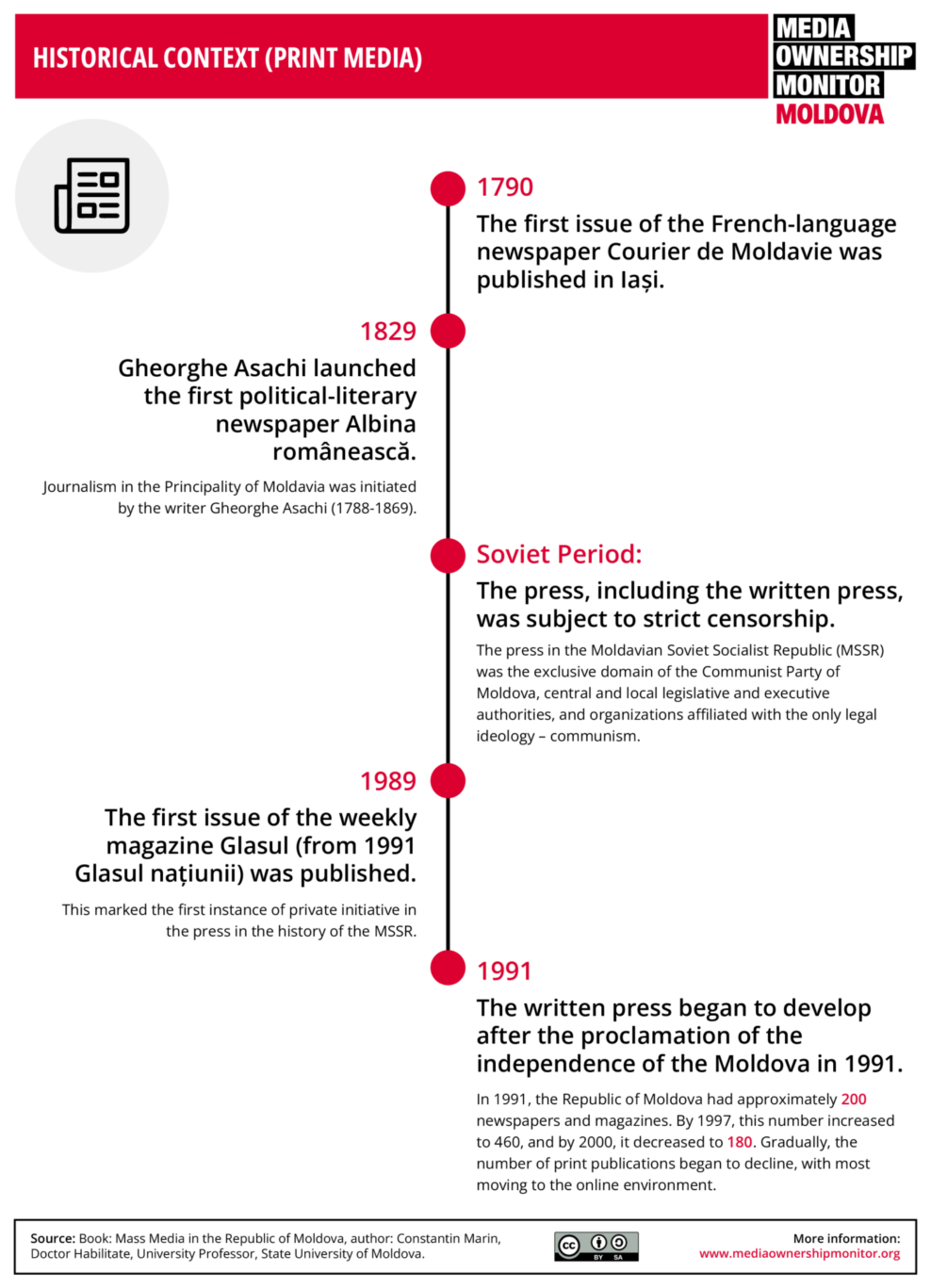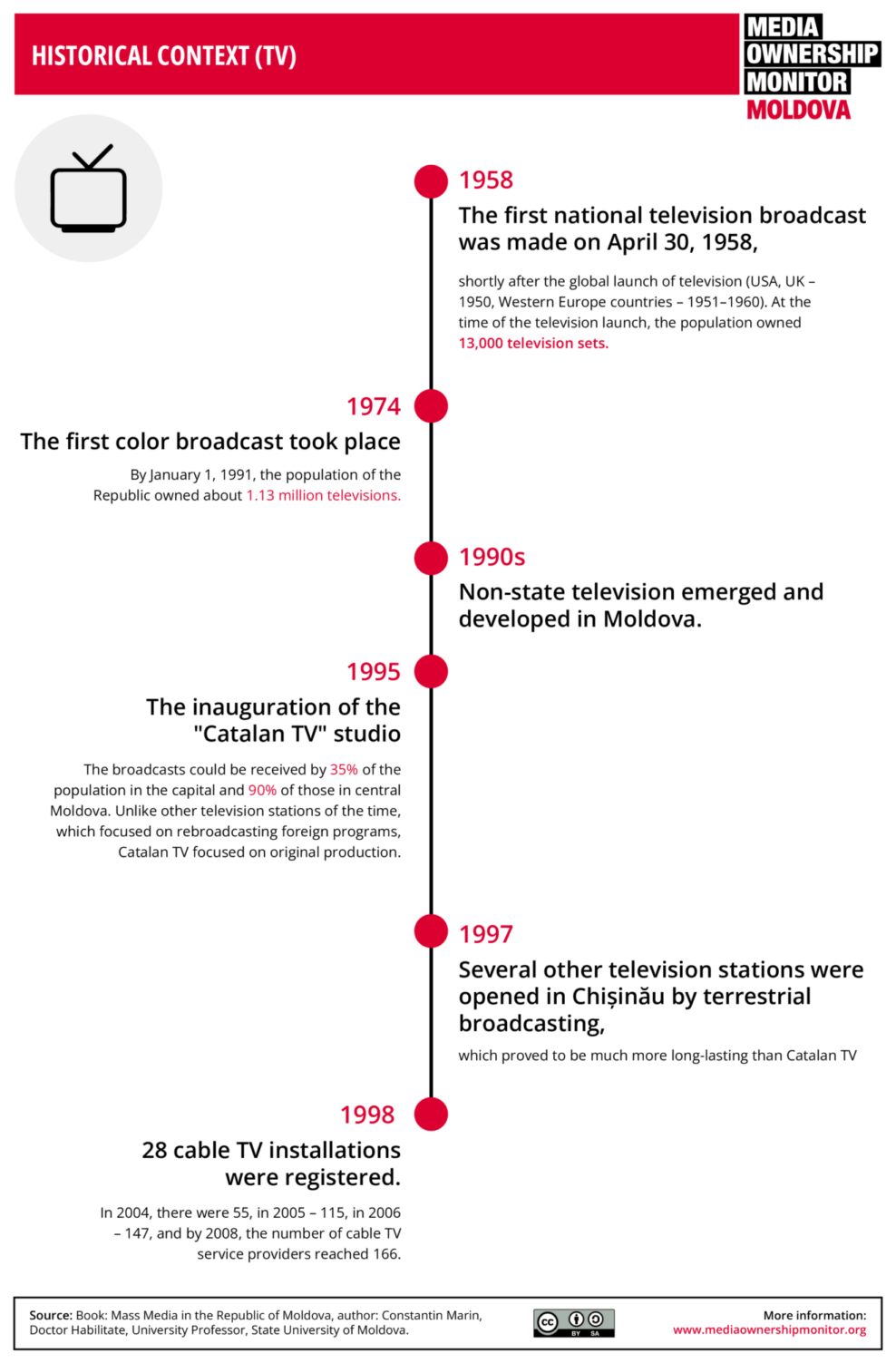History
Print press
The first print newspapers in the historical territories of Moldova were published in the late 18th and early 19th century, with the first-ever print newspaper in the region, the French-language "Courier de Moldavie", being published on February 8, 1790, in Iași (in current Romania).
The written press appeared and began to develop in the historical space of the Republic of Moldova in the 19th century. The first presence of the written press in this historical space was attested at the end of the 18th century: the French-language newspaper "Courier de Moldavie", the debut issue of which appeared on February 8, 1790, in Iași.
Journalism in the Principality of Moldavia was pioneered by the writer Gheorghe Asachi (1788-1869). On June 1, 1829, he launched the debut issue of the first political-literary newspaper, "Albina românească" - "Romanian Bee."
During the Soviet period, the press faced severe censorship. In the Moldovan Soviet Socialist Republic (MSSR), the press was the exclusive domain of the Communist Party of Moldova, the central and local legislative and executive authorities, along with the parties and organisations affiliated with communist ideology—the only legal doctrine at the time.
The year 1985 marked the beginning of social-political, economic, and spiritual restructuring, bringing a degree of liberalisation to print media. Newspaper circulation increased dramatically as publications began covering previously forbidden topics: political repression, peasant deportations, the 1946-1947 famine, national history, language issues, and the transition from Cyrillic to Latin script.
The first issue of the weekly magazine "Glasul" (The Voice) was published in February 1989, marking the first private press initiative in the MSSR's history. The publication, which was renamed "Glasul națiunii" (Voice of the Nation) in 1991, operated under the moral guidance of writer Ion Druță and was edited by writers Ion Vatamanu, Leonida Lari, and journalist Vasile Năstase. While the first two issues were printed in Vilnius, Lithuania, production later moved to Chișinău. Following Moldova's independence in 1991, the print press sector entered a period of expansion.
Moldova's print media landscape saw significant fluctuations in the years following independence. In 1991, when Moldova declared independence, approximately 200 newspapers and magazines were in circulation. This number peaked at 460 publications in 1997, before declining to 180 in 2000. Subsequently, the number of print publications continued to decrease as many media outlets transitioned to online formats.

Online Media
The Internet boom began in the late 1990s, sparking growing interest in digital journalism as technological infrastructure for accessing cyberspace developed and Internet adoption increased. According to the National Agency for the Regulation of Electronic Communications and Information Technology, Moldova experienced a dramatic 2100% surge in local Internet users between 2000 and 2007. The number of users tripled in 2005 compared to 2004 and doubled again in 2006. This upward trend continued in subsequent years.
Moldova lacks an official registry for media outlets, including online platforms, making it impossible to determine their exact number. A 2017 media census identified 181 news websites, while the Independent Journalism Center's 2021 study revealed that online media dominates the Moldovan media market with a 28% share.
Internet-based information sources are increasingly attracting consumers, who are steadily moving away from traditional platforms (print, radio, TV). Online media remains unregulated in Moldova, allowing anyone to create a website and publish editorial content. Despite ongoing discussions about the need for regulation in recent years, no consensus has been reached.
Radio
In the historical territory of the Republic of Moldova, radio broadcasting was introduced 85 years ago, i.e. in almost the same time frame as the establishment of radio broadcasting as a mass medium of information in the world (in the USA - in 1920, in Western European countries - between 1922 and 1926). The first telecommunication node was built in February 1928 in Balta - the then capital of the Moldovan RASS - in which radio broadcasts in Ukrainian and Russian were transmitted via a cable network.
On October 30, 1930, the first Romanian language broadcast was aired from a makeshift studio in the Tiraspol postal service. The use of an RV-57 transmitter allowed listeners to hear programs on wireless radio receivers. October 30, 1930, is considered National Radio Day.
Radio broadcasting emerged in Moldova's historical territory 85 years ago, coinciding with radio's global establishment as a mass medium (USA - 1920, Western Europe - 1922-1926). The first telecommunication node was constructed in February 1928 in Balta, then capital of the Moldovan ASSR, broadcasting Ukrainian and Russian programs via cable networks.
Radio broadcasting in Chisinau first started on October 8, 1939. The Radio Chisinau station at the time had a power of 20 kW and was equipped with British-made equipment. Broadcasting time was 6 hours a day. Radio Chisinau had three studios (a large one - for orchestras, military music, and choirs, another - for soloists-instrumentalists and vocalists, and a small one - for announcers). This radio service informed the population and countered the ideological influence of the USSR. The station existed for 300 days.
In the early 1990s, the liberalisation of media access led to the creation and diversification of the domestic radio market, driven by an emphasis on personal initiative. In 1993, “Unda Liberă” (“The Free Wave”) was launched as the first non-state radio station in Moldova. This milestone paved the way for the emergence of other private radio stations in the years that followed.

TV
The first national television broadcast took place on April 30, 1958, shortly after similar launches in other parts of the world (USA, Great Britain – 1950, Western European countries – 1951-1960). Initially, the domestic television service aired programs with a total duration of 3-4 hours, three times a week. At the time, there were 13 thousand TV sets in the country.
1974 saw the first colour broadcast. In the 1980s and 1990s, following the renovation of technical infrastructure, television in the MSSR experienced remarkable growth. During this period, the reception area for broadcasts was expanded, and by the 1990s, National Television broadcasts could be received across 98.9% of the territory of the Republic of Moldova. On January 1, 1991, there were about 1.13 million television sets in the country.
Until the 1990s, the National Television Service was the only domestic television operator. During this period, it was under the control of the State Television and Radio Broadcasting Committee of the MSSR (1958-1990). It was later assigned to the National Radio and Television (1990-1994), in 1994 - to the State Company "Teleradio - Moldova," and since 2004 - to the National Public Broadcasting Institution "Teleradio - Moldova."
In the 1990s, the first non-state television started to emerge and develop in Moldova. At first, there were a few neighbourhood studios broadcasting their own productions by cable or those taken from other TV centres: "Electron" in Tiraspol (1988), "SorTV" in Soroca (1988), "TVC" in Camenca (1989), "Satelit TV" in Chisinau (1989), etc. In 1994, the Moldovan-American enterprise "Eurocable" was founded in Chisinau, being the first multi-channel cable TV system, which took broadcasts from 8 foreign TV stations. In 1996, it became the property of another Moldovan-American company, "SUN TV". Cable TV soon spread to other parts of the country - to cities, district centres, and rural communities. 28 cable TV facilities were registered in 1998, 55 in 2004, 115 in 2005, 147 in 2006, and in 2008, the number of cable TV service providers reached 166.
At the same time, non-state on-air television was also being developed. The first such private station was "STV" from Slobozia (1990). By 1997, 23 studios had already obtained broadcasting licences from the Broadcasting Coordinating Council, 30% of them in Chisinau and the rest in other parts of Moldova.
In the mid-1990s, the "Catalan TV" studio, launched in Chisinau on August 31, 1995, gained a foothold on the television broadcasting market, which could be received by 35% of the capital's population and 90% of the inhabitants of central Moldova. Unlike the other TV stations of the time, which preferred to broadcast foreign programs, "Catalan TV" focused on original productions.
In 1997, several other on-the-airwaves TV channels were launched in Chisinau, many of which proved to be more enduring ”Catalan TV”. ”Pro TV” introduced a new approach to producing and presenting informative and analytical programs on the Moldovan television market. "NIT TV," with 14 frequencies, broadcasted programs over a large area of the country. Its informative and publicistic content, doctrinally affiliated with the PCRM (The Party of Communists of the Republic of Moldova), was produced 70% in Russian and 30% in Romanian. In 2012, the Broadcasting Coordinating Council (CCA) withdrew the broadcasting licence of “NIT TV” for failing to respect pluralism of opinion.
State of the Press Index
Compared to previous years, 2023 saw a slight improvement in the state of Moldova's media. However, the media environment in the country remains plagued by serious issues, according to the State of the Press Index in Moldova (ISPM) in 2023, released by the Independent Journalism Center (IJC) on February 5, 2024.
The report shows, among other things, that the most problematic areas for the media have been and still are the economic environment, information security, and the political context.
According to the ISPM, the laws regulating mass media have been amended/complemented with new, much-needed, and timely legal norms. However, a weak enforcement of legislation remains a major problem, making access to information of public interest particularly challenging. The study also reveals how the tense political, social, and economic backdrop throughout 2023 has affected media activity.
In 2024, Moldova ranked 31 out of 180 in the World Press Freedom Index of Reporters Without Borders (RSF), down 3 positions from 2023. Moldova scored 74.86 out of a maximum of 100 points, compared to 77.62 in the previous year.
"The Moldovan media is divided into pro-Russian and pro-Western camps. Oligarchs and political leaders strongly assert their editorial views," says the Reporters Without Borders organisation in its 2024 annual report.

